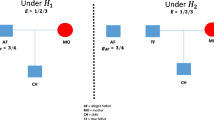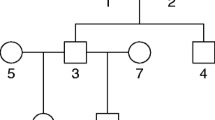Abstract
In forensic genetics, DNA profiles are compared in order to make inferences, paternity cases being a standard example. The statistical evidence can be summarized and reported in several ways. For example, in a paternity case, the likelihood ratio (LR) and the probability of not excluding a random man as father (RMNE) are two common summary statistics. There has been a long debate on the merits of the two statistics, also in the context of DNA mixture interpretation, and no general consensus has been reached. In this paper, we show that the RMNE is a certain weighted average of inverse likelihood ratios. This is true in any forensic context. We show that the likelihood ratio in favor of the correct hypothesis is, in expectation, bigger than the reciprocal of the RMNE probability. However, with the exception of pathological cases, it is also possible to obtain smaller likelihood ratios. We illustrate this result for paternity cases. Moreover, some theoretical properties of the likelihood ratio for a large class of general pairwise kinship cases, including expected value and variance, are derived. The practical implications of the findings are discussed and exemplified.
Similar content being viewed by others
References
Buckleton J, Curran J (2008) A discussion of the merits of random man not excluded and likelihood ratios. Forensic Sci Int Genet 2(4):343–348
Li CC, Chakravarti A (1988) An expository review of two methods of calculating the paternity probability. Am J Hum Genet 43(2):197
Slooten K, Meester R (2013) Probabilistic strategies for familial DNA searching. J Roy Statist Soc Ser C. doi:10.1111/rssc.12035
Thompson EA (1986) Likelihood inference of paternity. Am J Hum Genet 39(2):285
Thompson EA (2000) Statistical inference from genetic data on pedigrees. In: NSF-CBMS regional conference series in probability and statistics. JSTOR
Egeland T, Pinto N, Vigeland MD (2013) A general approach to power calculation for relationship testing. Forensic Sci Int Genet. doi:10.1016/j.fsigen.2013.05.001
Jacquard A (1972) Genetic information given by a relative. Biometrics 28(4):1101
Gjertson DW, Brenner CH, Baur MP et al (2007) ISFG: recommendations on biostatistics in paternity testing. Forensic Sci Int Genet 1(3):223–231
Nothnagel M, Schmidtke J, Krawczak M. (2010) Potentials and limits of pairwise kinship analysis using autosomal short tandem repeat loci. Int J Legal Med 124(3):205–215
Acknowledgments
The work of TE leading to these results was financially supported by the European Union Seventh Framework Programme (FP7/2007-2013) under grant agreement no. 285487 (EUROFORGEN-NoE).
Author information
Authors and Affiliations
Corresponding author
Appendices
Appendix 1: Mathematical derivations
We first derive Eq. 15. The probability for individuals with genotypes g and g ′ can be written as follows:
where P(g, g ′ | i) denotes the joint distribution conditioned on the individuals sharing i alleles IBD. For i = 0, 1, 2, this corresponds to the probability of two DNA profiles of unrelated individuals, a parent–child pair and identical twins, respectively. Our goal is to derive a closed formula for the following:
Consider first
The last sum is (L + 3) / 4 as shown previously for the paternity case and, for instance, the previous half-sib case follows.
Consider next the general case. We show below that
This is seen as follows:
-
The term
$$S_{1}=\sum_{g,g'} \frac{{(\kappa_{0} P(g,g'|0)+\kappa_{1}{P(g,g'|1))}}^{2}}{P(g,g'|0)} $$follows from Eq. 18.
-
Consider next S 2 = A + B, where
$$ A=2\kappa_{0}\kappa_{2}\sum_{g,g'} \frac{P(g,g'|0)P(g,g'|2)}{P(g,g'|0)}=2\kappa_{0}\kappa_{2}. $$Next,
$$\begin{array}{@{}rcl@{}} B&=&2\kappa_{1}\kappa_{2}\sum_{g,g'} \frac{P(g,g'|1)P(g,g'|2)}{P(g,g'|0)}\\ &=&2\kappa_{1}\kappa_{2}\sum_{g} \frac{P(g,g|1)}{f_{g}}\\ &=&2\kappa_{1}\kappa_{2} \left(\sum_{a=1}^{L}p_{a}+\sum_{a\neq b}\frac{\frac{1}{4}p_{a}p_{b}(p_{a}+p_{b})}{p_{a}p_{b}}\right)\\ &=&\kappa_{1}\kappa_{2}(L+1). \end{array} $$The expression for S 2 = A + B = 2κ 2 κ 0 + κ 2 κ 1(L + 1) follows.
-
For S 3, g = g ′ and so
$$S_{3}=\kappa_{2}^{2} \sum_{g} \frac{{P(g,g|2)}^{2}}{P(g,g|0)}=\kappa_{2}^{2} \sum_{g} \frac{f_{g}}{f_{g}} =\kappa_{2}^{2}\frac{L(L+1)}{2}. $$completing the derivation of Eq. 15.
Sibling index. Variance
The variance of the sibling index for true siblings is derived along similar lines as has been done for the paternity index. First, consider a homozygous first sibling with genotype (a a). For such a person, the expected squared sibling index is equal to
and summing this quantity, multiplied by \(p_{a}^{2}\) gives the contribution of the homozygotes to \(E\left [{\text {LR}}^{2}(\mathcal {H}_{\mathrm {P}})\right ]\), which turns out to be equal to
Similarly, the contribution of heterozygotes to \(E[{\text {LR}}^{2}(\mathcal {H}_{\mathrm {P}})]\) is
Together, this leads to
and this completes the derivation as
where the a P -function is given in Eq. 15. The variance is minimal for equal allele frequencies in which case it is given by
Half siblings. Variance
From Eq. 15,
which is again independent of the allele frequencies, and only involves the number of alleles on the locus that we consider. It is clear from this expression that the expected likelihood ratio in favor of being half-siblings is rather low.
A derivation analogous to the one for parents and children gives
leading to a variance equal to
which has a minimum equal to
obtained if and only if all allele frequencies are equal.
Appendix 2: Numerical calculations
For numerical calculations we have used the freely available R package ( http://cran.r-project.org/) and also functions (coded by TE) in the R package euroMix freely available from arken.umb.no/∼theg/euroMix_1.1.zip.. The database used for the examples is available as the data set db as shown below.
For the parent–offspring relationship, we have the explicit formula given in Eq. 10. Below follows calculations confirming the standard deviation of \({\text {LR}}(\mathcal {H}_{\mathrm {P}})\) for VWA in Table 7:

Alternatively, the calculations can be based on Eq. 15. See documentation of euroMix for further documentation. Below, the above answer is reproduced.

The below output shows that \({\text {LR}}(\mathcal {H}_{\mathrm {P}})\) can be skewed to the left as stated in “Skewness” section:

The mean, standard deviation and skewness of \({\text {LR}}(\mathcal {H}_{\mathrm {P}})\) are, respectively, 2.3281, 1.1344 and − 0. 3441. There are other examples, some with κ 0 > 0, leading to negative skewness. However, whether any of these examples correspond to possible (inbred or not) pedigrees remains unknown.
Rights and permissions
About this article
Cite this article
Slooten, KJ., Egeland, T. Exclusion probabilities and likelihood ratios with applications to kinship problems. Int J Legal Med 128, 415–425 (2014). https://doi.org/10.1007/s00414-013-0938-0
Received:
Accepted:
Published:
Issue Date:
DOI: https://doi.org/10.1007/s00414-013-0938-0




